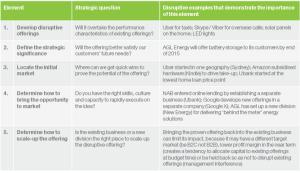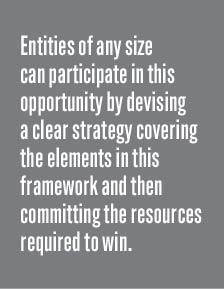The great business model disruption
Today’s business models won’t stand up to the tsunami of technology and digital disruption coming their way
- First it was telephony, now it’s financial services, next it’s sustainability – sectors in which use of the environment is core business (electricity, gas, transportation, water and waste) – that will succumb to business model disruption
- New technologies and digital platforms are enabling the great disruption of business models that don’t deliver efficient outcomes for shareholders, customers and society
- This five part framework is an enabler for businesses to change their business models to withstand the impending disruption.
David Hershan – June 2015
Disruption is coming. Better business models for operating key sectors of our society now exist.
The next wave of disruption will impact on sectors in which use of the natural environment is core business – electricity, gas, transportation, water and waste management – which have only incrementally changed over the past 100 years. Most of the existing infrastructure in these areas was developed to meet the needs of Australia at a very different stage of development – sparse population, abundance of land and little concern for limiting adverse environmental impact. In addition, older assets still used to operate our cities, like office buildings, which are on average 31 years old in Melbourne
(Wilkinson 2009), were built for an era of low utility prices and where tenants yields were not tied to access to creative spaces, natural air flow and light.
The opportunity for sustainable disruption is significant due to the age of the business models, infrastructure and assets in these sectors. This opportunity can be exploited by creating new business models that utilise new technologies and digital platforms to deliver better outcomes for customers.
The five part framework set out in this article, leverages 20 years of research in the field of ‘disruptive innovation’,
for companies to avoid the rapid obsolescence of their existing business models. Disruptive business models deliver new offerings that create new markets or invade established markets by better satisfying customers’ needs
(Economist 2015). They do this partly by harnessing new technologies, but also by developing new offerings that exploit old technologies in new ways.
For an example of the inevitability of sustainable disruption, let’s do a quick dive into the electricity market. The 100 year old model of generating electricity in regional areas and transmitting it hundreds of kilometres to major population centres is currently being challenged. On the economic front, ‘old model’ electricity prices for households have risen 100% in the past six years (Chester 2015) and the economics of solar, now on over 26% of eligible Australian homes (Grattan Institute 2015) is already more favourable. On the social front, there is more community dissent to AGL’s coal seam gas project in Gloucester, NSW (Hamman 2015) than solar panels or heat pumps installed by neighbours in your street. Furthermore, the environmental impact of energy consumption, currently a staggering 65% of Australia’s emissions (Wood 2015), can be drastically improved by the adoption of proven new technologies in the areas of electrification (electric vehicles, induction cooktops), renewable energy (solar, energy storage) and energy efficiency (sustainable building technologies like LEDs and remote control and automated appliances).
The framework adapted primarily from Christensen (1995, 2000 and 2012) to develop and execute new offerings that drive sustainable disruption has five key elements. All of these elements need to be considered in parallel:
Framework for developing your disruptive offering
-
Developing disruptive offerings
This involves developing new ideas and assessing cutting edge offerings that will better satisfy your customers’ future needs using proven clean technologies, digital or a combination of the two. The objective is to identify offerings that have the potential to soon create new markets or invade established markets.There are many structured ways to assess and develop disruptive offerings. One approach currently popular in the tech world is getting staff together (in particular engineers and web developers) for an off-site ‘hackathon’.
-
Define their strategic significance
This requires an assessment of whether the new offering might immediately or soon better meet the needs of future customers. If the new offering might better address the needs of the customer in the near future it is strategically significant.For example, Tesla’s Powerwall and Powerpack battery storage offerings are likely to be considered strategic by electricity retailers with a high proportion of customers with solar PV on their homes.
-
Locate the initial market
At this point, market research is seldom helpful. When a company needs to make a strategic commitment to a disruptive new offering, it may be that no concrete market exists.With the likely emergence of new markets or market segments, managers will need to create information about such markets for example, who is the target customer and what is the right price point?Examples of approaches to selecting an initial market include: by geography (Uber), sales channel (Xiaomi started out as online only), price point (Ubank) and where the economics work best (Tesla has identified Germany and Australia for its Powerwall battery storage offering) (Parkinson 2015).
-
Determine how to bring the offering to market
To commercialise the new offering, companies must protect the commercialisation team from the processes and incentives that are geared to serving existing customers.Where the new offering needs new processes and values, because the offering is not a direct fit with the existing organisation and needs new capabilities, companies should create a new space where the necessary capabilities and processes can be developed.Options available for creating a new space for the commercialisation team include creating new organisational structures within the corporate boundaries; spinning the team out into an independent organisation; or acquiring a different organisation whose processes and values closely match the requirements of the new task.
-
Determine how to scale-up the offering
Similar to the decision on the structure for commercialising the new offering, a decision needs to be made on where to scale-up the offering, once it is proven.Bringing the proven offering back into the existing business can limit its impact, because it may have a: different target market (be B2C not B2B), lower profit margin in the near term (which creates a tendency to allocate capital to existing offerings at budget time), or be held back so as not to disrupt existing offerings (management interference).Up to now shareholders have had to pay a premium for participation in new opportunities arising from new technology and digital platforms as the new business models have been developed by start-ups and nimble mid-size companies before being bought by established industry participants. This will become an increasingly high risk strategy for established industry participants given the scale of the opportunity and the risk of rapid business model obsolescence. Entities of any size can participate in this opportunity by devising a clear strategy covering the elements in this framework and then committing the resources required to win.
References:
Bower, J & Christensen, C 1995, Disruptive technologies: catching the wave, Harvard Business Review, viewed May 2015, <http://hbr.org/1995/01/disruptive-technologies-catching-the-wave>
Chester, L 2015, The privatisation of electricity: claims, myths and facts, The Economic and Labour Relations Review, viewed May 2015, <http://elr.sagepub.com>
Christensen, C & Overdorf, M 2012, Surviving disruption, Harvard Business Review, viewed May 2015, <http://hbr.org/2012/12/surviving-disruption>
ClimateWorks Australia 2015, Australia’s energy productivity potential, viewed May 2015, <http://climateworks.com.au>
Clover, I 2014, SunEdison announces IPO filing for TerraForm Power unit, PV Magazine, viewed June 2015, <http://www.pv-magazine.com/news/details/beitrag/sunedison-announces-ipo-filing-for-terraform-power-unit_100015270/#axzz3e1sRq1qW>
Economist 2015, What disruptive innovation means, viewed May 2015, <http://www.economist.com/blogs/economist-explains/2015/01/economist-explains-15>
Hamman, P 2015, CSG more trouble than it’s worth for AGL, The Sydney Morning Herald, viewed June 2015, <http://www.smh.com.au/business/mining-and-resources/csg-more-trouble-than-its-worth-for-agl- 20150313-1421wi.html>
Parkinson, G 2015, Tesla say battery storage already makes economic sense for Australia consumers, RenewEconomy, viewed May 2015, <http://reneweconomy.com.au/2015/tesla-says-battery-storage-already-makes-economic-sense-for-australia-consumers-40655>
Wessel, M & Christensen, C 2000, Meeting the challenge of disruptive change, Harvard Business Review, viewed May 2015, <http://hbr.org/2000/03/meeting-the-challenge-of-disruptive-change>
Wilkinson S, Kimberley J and Reed R 2009, Delivering sustainability through the adaptive reuse of commercial buildings: the Melbourne CBD challenge, PPRES Sydney, viewed May 2015, <http://dro.deakin. edu.au>
Wood, T 2015, Solar PV analysis (Grattan Institute report soon to be published)
Want to know more?
If you would like Right Lane to help your organisation develop and execute growth opportunities, get in touch today.
Right Lane Review
This is article 2 from the June 2015 edition of Right Lane Review: Learning and growth. Full newsletter here.

